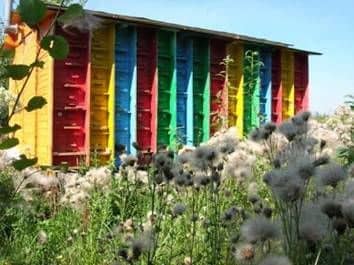Features of the contents of bees in the pavilion

In Europe, the overwhelming number of bee colonies in amateur conditions is found in pavilions, which is explained by the high population density and the lack (or inadequacy) in this regard of the area for free accommodation of hives. In addition, the pavilion content of bees has a number of advantages.
For pavilions, special types of hives with opening rear walls have been developed, which allows placing beehives in several tiers. Usually the volume of the hive in the pavilions does not exceed the volume of the 12-frame hive Dadan-Blatt (about 100 dm3). In recent years, such a volume of the hive is considered insufficient, and the withdrawal and setting of the frames through the back wall are considered inconvenient. Many beekeepers – pavilion begin to move to the usual multi-hull beats Langstroth – Ruth.
Pavilion content of bees among fans is becoming more common. What determines the increased interest in the pavilion content of bees?
Perhaps, the following:
The productivity of bees in insulated pavilions is higher than in hives that are located freely, since in pavilions the conditions for keeping and developing bee colonies are more favorable;
The pavilion apiary is compact, and if an attic space is adapted for it, bees do not pose a danger to humans and animals, since they fly above their height;
Possibilities for the care of bees in the pavilion are much wider than on the site, because the hives can be inspected in any weather after the pavilion has warmed to the required temperature, and in the dark – by switching on the lighting;
Wintering bees in good pavilions is better than at will, since they provide reliable ventilation, and air temperature by several degrees (up to 5-8 њ C) higher than the average daily in the street, as its sharp drops are excluded in the area where the apiary is located;
In the pavilion, the longevity
The pavilion allows for the artificial regulation of the temperature in the room from the simplest, manual, switching on of the heaters in the case of strong cooling to its automatic regulation within narrow limits, which provides more favorable conditions for the wintering of bees and preserves the strength of the family for rapid development in the spring;
In the active period of life of bee families in a pavilion located in the attic of a residential house, a stable temperature of 18-26 њ C is established, regardless of its diurnal fluctuations from the outside, which also favors the development of bee colonies and reduces their desire for swarming. Bees live longer, their performance improves.
All the above is true for insulated pavilions with a thickness of wooden walls, ceiling and floor of not less than 100-120 mm or with equivalent thermal insulation.
These advantages attract a growing number of supporters to the pavilion method of keeping bees, and in conditions of small-sized plots in collective gardening this method can be the only one that allows keeping bees. The arrangement of pavilions of various types is discussed in detail in the books.
To ensure the safety of people and animals, it is necessary that on the way of bees in front of the vents at a distance of up to 4-5 m, a quiet zone was organized, unavailable to outsiders. On the boundaries of this zone, green plantations should be planted in the form of a natural fence with a height of 2.5-3 m, part of the zone may be confined to a blank wall of the structure or a fence. In such conditions, the bees, flying out of the tap, rise above the growth of a person and do not cause trouble.
For more than 15 years I kept bees in the attic, there was not a single incident of their unprovoked attack on people or animals, but nevertheless the organization of the green enclosure of the apiary’s arrival zone is very useful, because it protects the bees from the wind and thus helps them to better orientate, excludes the drift of bees by gusts of wind and reduces their deaths due to freezing in cold weather.
When constructing a heat insulated pavilion, it is important not to allow one of the most common mistakes, which consists in laying steam-waterproof material, for example, roofing felt under the lining. And in no case should the pavilion be covered with sheets of iron.
In the cold season on the inside of such materials, moisture condenses through the wall from the room, because of this, most of it is damp and, therefore, poorly retains heat, and quickly rot. The vapor-permeable layer can be placed on the inside of the wall, and only the windproof layer, which allows good water vapor transmission, is allowed from the outside. It is suitable for glassine, building cardboard, plaster.
One of the best heat-insulating backfill frames is a mix of sawdust and 5% lime (20 buckets of sawdust lime bucket).
Features of the contents of bees in the pavilion
